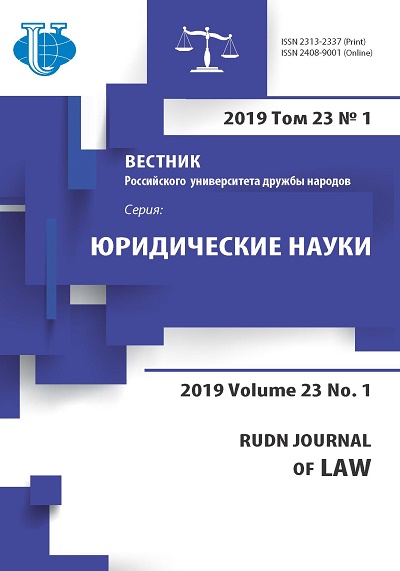THE VALUE OF DIGITAL EVIDENCE IN CRIMINAL INVESTIGATIONS
- Authors: Ostrovsky O.A1
-
Affiliations:
- Altai State University
- Issue: Vol 23, No 1 (2019)
- Pages: 123-140
- Section: LAW AND DIGITAL TECHNOLOGIES
- URL: https://journals.rudn.ru/law/article/view/21178
- DOI: https://doi.org/10.22363/2313-2337-2019-23-1-123-140
Cite item
Full Text
Abstract
Modern information systems, such as e-learning, e-voting, e-health, etc., are often used inappropriately for irregular data changes (data falsification). These facts force to review security measures and find a way to improve them. Proof of computer crime is accompanied by very complex processes that are based on the collection of digital evidence, forensic analysis and investigation. Forensic analysis of database systems is a very specific and complex task and therefore is the main source of inspiration for research. This article presents the fact that classical methods of collecting digital evidence are not suitable and effective. To improve efficiency, a combination of well-known, world-independent database technologies and their application in the field of forensic science are proposed. It also offers new directions for research in this area.
About the authors
Oleg A Ostrovsky
Altai State University
Author for correspondence.
Email: ostrovskii_80@mail.ru
PhD-student, Department of Criminal Procedure and Criminalistics, Faculty of Law, Altai State University
77/83, Leo Tolstoy st., Tomsk, Russia, 634021References
- Aver'yanova, T.V., Belkin, YU.G., Koruhov., Rossijskaya E.R. (2002) Kriminalistika: ucheb. dlya vuzov [Forensics: studies. for universities]. M. Pp. 960. (in Russian).
- Azemovie, J., Music, D., (2009) Efficient model for detection data and data sheme tempering with purpose of valid forensic analysis. ICCEA Manila, Philippines. 211 p. (In English).
- Bagutdinov, R.A. (2017) Gnoseologicheskie aspekty k opredeleniyu naznacheniya i sostava STZ v zadachah proektirovaniya i razrabotki robototekhnicheskih kompleksov [Epistemological aspects to the definition of the purpose and composition of the FCZ in the tasks of designing and developing robotic systems] // Programmnye sistemy i vychislitel'nye metody. № 1. Pp. 39-45. (in Russian).
- Bagutdinov, R.A. (2014) Issledovanie novejshih informacionno-kommunikativnyh tekhnologij v srednem professional'nom obrazovanii [Study of the latest information and communication technologies in secondary vocational education]//V sbornike: Nauchnyj poisk v XXI veke Materialy I mezhdunarodnoj nauchnoj konferencii po evrazijskomu nauchnomu sotrudnichestvu. Pp. 39-42. (in Russian).
- Bagutdinov, R.A. (2018) Classification characteristic for processing heterogeneous data. International Journal of Open Information Technologies. Т. 6. (8). Pp. 14-18. (In English).
- Bagutdinov, R.A. (2018) The processing of heterogeneous data for multisensory systems of technical vision on the example of analysis of temperature and gas concentration. In the collection: Youth and modern information technologies. Collection of works of the XV International scientific-practical conference of students, graduate students and young scientists. National Research Tomsk Polytechnic University. Pp. 25-26. (In English).
- Bagutdinov, R.A., Zaharova, A.A. (2017) The task adaptation method for determining the optical flow problem of interactive objects recognition in real time / Journal of Physics: Conference Series. Т. 803. (1). (In English).
- Chisum, J.W. (1999) Crime Reconstruction and Evidence Dynamics, Presented at the Academy of Behavioral Profiling Annual Meeting, Montrey, CA. 623 p. (In English)
- Ben-Gan, I., Sarka D., Wolter, R. (2005) Inside Microsoft SQL Server 2005: T-SQL Programming, Microsoft Press. 544 p. (In English).
- JoyMalmgren, M., (2007) An Infrastructure for database tamper detection and forensic analysis. The University of Arizona, 42 p. (In English).
- Karakoc, M.M., Varol, A. (2018) Can erase montage traces permanently in audio files /2018 6th International Symposium on Digital Forensic and Security (ISDFS), Antalya. Pp. 1-5. (In English).
- Pavlou, K., Richard T. (2005) Snodgrass, Forensic Analysis of Database Tampering, from Department of Computer Science, University of Arizona, 3531 p. (In English).
- LeFevrey, K., Agrawaly, R., Ercegovac, V., Ramakrishnan, R., Xuy Y., DeWitt, D. (2004) Limiting Disclosure in Hippocratic Databases, Proceedings of the 30th VLDB Conference, Toronto Canada. 1277-1288 p. (In English).
- Li, Y., Zhang, X., Li, X., Zhang, Y., Yang, J., He, Q. (2018) Mobile Phone Clustering From Speech Recordings Using Deep Representation and Spectral Clustering / in IEEE Transactions on Information Forensics and Security, vol. 13, no. 4. Pp. 965-977. (In English).
- Muller, L. (2008) New version of EnCase includes stand-alone utility to capture RAM. Available at: URL: http://www.forensickb.com/2008/06/new-version-of-encase-includes-stand.html [Accessed Januare 17th 2019] (In English).
- Ostrovskij, O.A. (2018) Algoritm meropriyatij po analizu situacii pri podozrenii v sovershenii prestuplenij v sfere komp'yuternoj informacii s uchetom specifiki istochnikov dannyh ehtoj informacii [Algorithm of measures to analyze the situation in case of suspicion of committing crimes in the field of computer information, taking into account the specifics of the data sources of this information]// Pravo i politika. 10. Pp. 32-37. (in Russian).
- Pastuhov, P. S., Losavio, M. (2017) Ispol'zovanie informacionnyh tekhnologij dlya obespecheniya bezopasnosti lichnosti, obshchestva i gosudarstva [The use of information technology to ensure the security of the individual, society and the state] // Vestnik Permskogo universiteta. YUridicheskie nauki. 36. Pp. 231-236. (in Russian).
- Reyes, A. (2007) Cyber Crime Investigation, Syngress Publishing, 432 p. (In English)
- Sabah, S. (2007) Al-Fedaghi, Beyond Purpose-Based Privacy Access Control, Computer Engineering Department Kuwait University, 165-169 p. (In English).
- Spyrou, T., Darzentas, J., (1996) Intention Modeling: pproximating Computer User Intentions for Detection and Prediction of Intrusions. 319-336 p. (In English).
- Gupta1, Sh.K., VikramGoyal, Gupta, A. (2006) Malafide Intension Based Detection of Privacy Violation in Information System, Bagchi and V. Atluri (Eds.): ICISS 2006, LNCS 4332, pp. 365-368. (In English).
- Warf, B. (2001) Segue ways into cyberspace: Multiple geographies of the digital divide. Environment and Planning(B), 28(1). Pp. 3-19. (In English).
- Wen, B., Luo, Z., Wen, Y. (2018) Evidence and Trust IoT: Collaborative Security Mechanism / 2018 Eighth International Conference on Information Science and Technology (ICIST), Cordoba. Pp. 98-9. (In English).
- Waleed, J., Abdullah, D.A., Khudhur M.H. (2018) Comprehensive Display of Digital Image Copy-Move Forensics Techniques /2018 International Conference on Engineering Technology and their Applications (IICETA), Al-Najaf. Pp. 155-160. (In English).
















